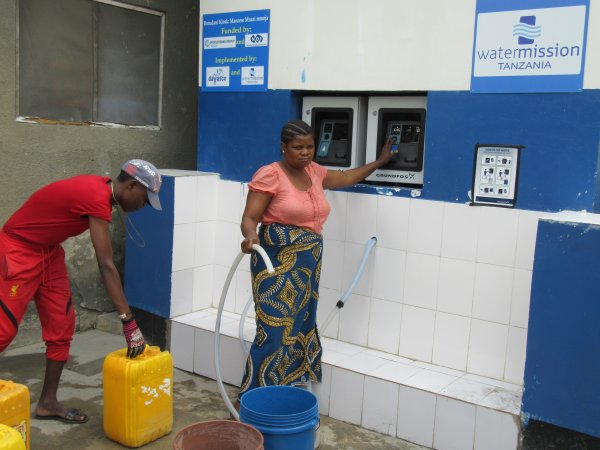Climate smart water ATMs communities can bank on
Access to water and sustainability of water supply are major issues, especially in remote off-grid areas. A project in Tanzania, co-funded by NDF and the World Bank, has now pioneered and tested a water management concept that successfully tackles these challenges with big wins for the communities and the environment.
The project Climate Smart Solutions for Small-scale Water and Energy Supply introduced a chain of intelligent ATMs at 26 water points in rural and urban areas where urban users purchased water via their cell phones.
Economic and environmental sustainability
Rasoul Mikkelsen, Director, Strategic Partnerships for Grundfos Lifelink, who was involved on the project’s technical side, cites efficiency of revenue collection as the project’s major success factor, which also brought startling ecological payoffs.
“A lot of evidence showed that by improving the efficiency and transparency of a water payment system, we could actually increase the sustainability of the water points.”
Revenues from the payments also support the operation and maintenance of the systems ensuring continuity and reliability. According to Mikkelsen, by paying for water, people tend to give it more value rationalising it and consuming just enough for daily use.
In comparison, non revenue water sources didn’t always fare as well. “People I’ve seen tend t be more wasteful with water when they don’t pay. They might leave a tap running or overwater their gardens without thinking.”
The operation itself is also environmentally clean since it is based on solar power. The renewable power scheme also offers local water users a chance to charge their mobile phones and household LED lamps at the point of purchase, which in turn boosts revenue for the operators to support full cost recovery.
System brings major social advances
On top of these environmental and economic wins, Mikkelsen also cites the project’s socio-economic impact: “By giving people sustained access to water when they want it, in a way that is mechanised, time that was once spent fetching water can be devote to developing their livelihoods.” Women can go out to work, children can more regularly attend school, and families can expand their social opportunities.
What about corruption? Backed by a transparent closed system, reporting real time data, the system is cash free, which helps reduce the possibility of misuse. It also means that revenues do actually flow and money for operation and maintenance is available for continuity.
The question is still what happens to the poorest of the poor who don’t own cell phones or have funds to pay? Mikkelsen explains that in the remote rural testing areas, water committees have been assigned to take shared responsibility for setting the fees and ensuring that access is made free of charge to those in need. Family members can also transfer credits electronically to each other within the system.
But there are challenges
While this might sound all too good to be true, Mikkelsen concedes, there are challenges.
To start with access to water is a very political hot button issue. Many people still believe that water should be free of charge. “It’s getting better,” says Mikkelsen. “But for ultimate financial viability at the end of the day, we need governments, donors, and community leaders, everyone to acknowledge that water has a price and that people have to pay or no way can we make this work.”
Mobilisation is also a challenge. “We can’t just drop the machine and say now everyone pays for the water.” Projects like this need training, awareness building and local government engagement. This kind of complex innovation also takes time and cost to develop and test. “The Grundfos LifeLink system was started in 2009,” Mikkelsen recalls, “so that’s nearly 10 years of feasibility studies to be ready for scale – and with very high capital expenditure along the way.” The Tanzania project grew from a past feasibility study, funded by NDF, which built on an earlier proven concept from a pilot in Kenya, which was supported by the Nordic Climate Facility.
Highly successful and ready for scale
But the good news is that the Tanzania project has now been pronounced a success. The value proposition is there. In one rural site where the payment system was tested, a village of 2,500 people covered costs for operation and maintenance while creating a 4,250 USD surplus, all in the first year. “I’ve been in the development sector all my life,” Mikkelsen recounts “but I’ve never seen a project that covered costs and created a surplus in such a short time.”
The World Bank, together with private sector experts and investors, is preparing to pick up the project and run with it on a large scale. Mikkelsen believes this attests to NDF’s ability to fund the right feasibility studies, and deliver the right results, ready for private sector scale up.


